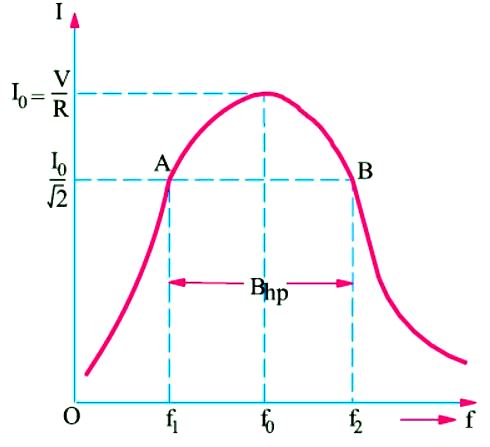Resonance Curve and Half Power Bandwidth of Resonant Circuit
Resonance Curve and Half Power Bandwidth of Resonant Circuit
A discussed earlier, in an R-L-C circuit, the maximum current at resonance is solely determined by circuit resistance R (∵ X = 0) but at off-resonance frequencies, the current amplitude depends on Z (where X ≠ 0). The half-wave bandwidth of a circuit is given by the band of frequencies which lies between two points on either side of f0 where current falls to Io /√2. Narrower the bandwidth, higher the selectivity of the circuit and vice versa. As shown in Figure (A) the half-power bandwidth AB is given by
AB = Δf = f2 − f1 or AB = Δω = ω2 − ω1 where f1 and f2 are the corner or edge frequencies.
As seen, P0 = Io2R. However, power at either of the two points A and B is P1 = P2 = I2R
= (Io/√2)2 R = Io2R/2 = (1/2) Io2R = (1/2) x power at resonance

That is why the two points A and B on the resonance curve are known as half-power points and the corresponding value of the bandwidth is called half-power bandwidth Bhp. It is also called –3dB bandwidth. The following points regarding half-power point A and B are worth noting. At these points,
1. Current is Io/√2
2. Impedance is √2.R or √2.Z
3. P1 = P2 = P0/2
4. The circuit phase angle is θ = ± 45°
5. Q = tan θ = tan 45° = 1
6. ![]()
AdBlock-2

It is interesting to note that Bhp is independent of the circuit capacitance.
Read article – R-L-C circuit
Visit NCERTplanet.com for NCERT solutions and Textbook downloads




